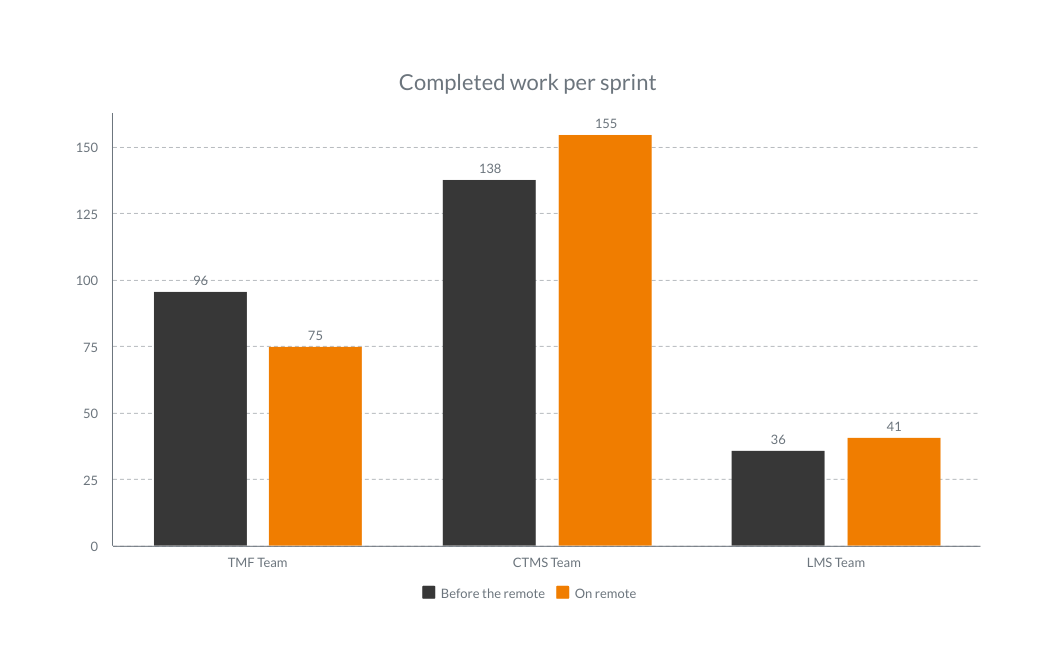How we’ve moved to remote: challenges, solutions and findings
April 28, 2020

Over a month ago, we at Flex Databases moved our employees to work from home due to a pandemic outbreak. We have met challenges, part of which are solved, and some are still ongoing. The situation is going to develop further, but the time has come to take a deep breath and review where we are.
Challenges & solutions:
Challenge #1: Potential productivity drop
Multiple pieces of research show a 12-15% less productivity for remote distributed teams compared to on-site teams.
Solution: We have noticed both a slight growth in productivity and a slight drop. Here’s a comparison of two sprints results for three of our teams, before the remote and on remote:
In March (when we have moved our teams to remote), we had an impressive rise in completed tasks, and the trend is the same for April. It’s a good thing and a good sign, but we do expect numbers to drop due to the previously mentioned researches background, showing lower productivity for distributed teams.
Challenge #2: How the new hires will perform
One of the departments recently grew by 56% due to the growth of our company. We had our doubts about how our new hires will perform, given their short history in our company.
Solution:
- Smooth, successive move: Project Coordinators moved first, Project Managers followed, and there is still a possibility to visit the office if there is a need.
- Daily progress catch-up meetings within teams: the obligation to report not only to the line manager but everyone in the team adds responsibility. Daily meetings also provide a possibility to help each other and operatively redistribute the workload if someone is struggling or stuck. Departments’ Team Leaders visit all daily meetings and have kept an ability to make fast and efficient managerial decisions the same way as they did it when the full team was present on site. Recommended meeting duration – 15 minutes.
- Not everyone understood the true meaning of daily meetings, and sometimes we’ve faced employees showing off instead of telling the truth. Over time, things have settled, and it’s not an issue anymore.
- Mutual responsibility: when we work as a team and not as individuals, we share workload, accountability, and results. It means that if anyone is failing a task – everyone takes a hit.
- Video calls: isolation brings a lot of mind-related issues and, seeing each other’s faces via video instead of talking to the black screen and, a camera makes everything better. In the end, we are social creatures and, a lot can be said in a smile or a brow raise.
Challenge #3: Lack of face-to-face communication: a drop in productivity and miscommunication
While at the office, we were able to reach out to one another within seconds in open space or during lunch and breaks. Now we will have to call and make sure that the person is not in another call. Our Director, Product Delivery & Support, has faced a communication-related issue with the need to deliver information from C-level management to teams promptly. There was also a concern, regarding all employees without a strict team attachment, like our UI/UX designer.
Solution: Since our move to the Agile management approach last June, team members have almost entirely mastered the science of being a team – and it shows! Better internal understanding helps to prevent most of the possible communication issues and solve them if any, fast and efficient. Agile itself has a lot of mechanics, such as daily stand-ups, like mentioned above daily meetings, for a sufficient remote work. Director, Product Delivery & Support, notes that he himself and SCRUM-masters invested a lot of time to establish proper information circulation from management to teams and now it works just as it should be. All of the out-of-teams people got someone from management to communicate directly to keep up with everyone else.
Challenge #4: Underloaded teams
There is a team with a reasonably changing volume of workload, and there was an issue with people possibly staying without tasks to do.
Solution: Well-established teams also help with workload distribution – we share tasks between the underloaded and overloaded teams to create balance and keep the process going well. Since Flex Databases’ goal is to make our product perfect there is always room for improvement and a bunch of fresh tasks from our Product Manager.
Challenge #5: Responsible self-management approach
Since it is more challenging to control personnel remotely, the worse concern was people who are out of tasks to do not proactively seek new tasks and manage their own workload.
Solution: Luckily, all employees showed a high-level of work ethics and readiness to help each other to balance the workload out. There was no issue regarding someone’s low workload, and the challenge eliminated itself. Looks like we should trust our employees more.
Challenge #6: Too many meetings
A massive increase in the number of meetings – due to many one-by-one meetings, even small ones, it’s hard to focus. It seems like the workload is growing huge when, in fact, the difference in workload is not that big while the burden is enormous.
Solution: The meeting that could have been an email is now an email. We keep meetings as short and efficient as possible. There is still room for improvement, and we are looking for new ideas and solutions.
Problems that we have to address:
- 20% FTE growth for managerial level positions.
- Work from home erases the difference between working days and weekend, it is hard to keep work-life balance.
- Little things that are important but do not look important enough have fallen through the cracks as there is no cooler talk anymore.
While we are all at home, some of us experience an information vacuum about what is going on in the company and how we are doing. That is why we have all-company sync-ups. We share news, talk, and see each other, and it helps us to get through the times of uncertainty.
Forced move to self-isolation and work from home gives a lot of food for thought. Do we need an office when all of this is over? How are we going to work when there is a green light? Only time will tell. But what’s important is the fact that we all are together and here for each other, our product, our clients – and nothing can stop us.



